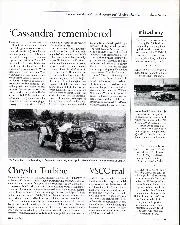
Chrysler Turbine
Michael Bowler's recent letter mentioning turbine cars reminds me that in the mid '60s, I drove a turbine-engined Chrysler Ghia coupe. Chrysler had such faith in it they were flying…
Fans of the Porsche 917/30 lionise the car because it was so fast and capable that it effectively killed the Can-Am series. Haters villainise it for the same reason.
The predecessor of the ‘Turbo Panzer’, the 917/10, had breezed to the championship in 1972 so convincingly that the once all-conquering McLaren Cars team quit Can-Am with its tail between its legs. The next year, the 917/30 was roughly two seconds per a lap faster than an upgraded, well-driven 917/10. Indeed, driver Mark Donohue claimed it to be “the perfect race car,” after his dominant run in 1973. But it was perfectly deadly, too. At least to the Can-Am series as a whole.
With no cars able to compete with the 917/30, fields eventually dwindled until it was essentially just Donohue – inevitably on pole by a light-year at most rounds – being trailed by five outclassed 917/10s and a rag-tag collection of outdated McLarens and near-obsolete Lolas. By the end of the 1973 season it was clear that heroic measures were necessary to keep the series alive, so the organisers instituted a controversial fuel-consumption formula that rendered thirsty turbocharged engines uncompetitive.
Porsche predictably bailed out. But no fresh blood materialised. The only new car of 1974, the Shadow DN4, dominated a truncated schedule featuring only five races. The season ended early when the final event at Riverside was cancelled because, as a press release at the time put it, “the costs involved simply aren’t justified by the quality of the competition being offered.”
“That Can-Am survived as long as it did was nothing short of a miracle. Because, in truth, the series was the canary in the coal mine”
It’s often said that Can-Am – the uniquely muscular road-racing series whose success was built on the lack of rules – was destroyed when the new regulations were finally brought in, but this gets things rather backwards. That Can-Am survived as long as it did was nothing short of a miracle. Because, in truth, the series was the canary in the coal mine whose death signalled an inflection point that would change the sport.
The Canadian-American Challenge Cup began in 1966, when racing was on the cusp of a technological revolution underwritten by unprecedented sums of sponsorship money. The next decade would bring the development of wings, slick tyres, turbocharging and a host of incremental upgrades that caused speeds to skyrocket. Up until then, racing had always been about making cars go faster. But after the breakthroughs of the 1960s, the rule makers were primarily concerned with slowing them down.
The impact of Can-Am’s anything-goes formula was seen most clearly in lap times that plummeted while the series lasted. In 1967 Bruce McLaren put his bright-orange M6A on the pole at Road America with a lap at 2min12.6sec, or 108.597 mph. In 1973 Donohue pushed the 917/30 to a lap of 1m57.518sec, at 122.534 mph. That’s a 14mph average lap speed improvement in six years. At Watkins Glen, while driving a backup car with the wrong gearing, Donohue qualified on the pole with a time nearly a second quicker than Ronnie Peterson would go in his pole-sitting Lotus 72 in the US Grand Prix two months later.

Can-Am was lucky, in a way, in that it was off the beaten path and didn’t attract serious factory interest until late in the day. Early on it was dominated by race car constructors (McLaren and Lola) that built clever but straightforward chassis and American engine tuners such as Traco and Gary Knutson, who hogged out pushrod V8s to displace 8.0 litres and more. Then Porsche showed up and rewrote the rules of the game.
The same R&D team behind back-to-back wins at Le Mans in 1970 and 1971 now tackled Can-Am, with Donohue serving as the test driver and chassis engineer. The 917/10 they created was a world-beater, and the 917/30 was an order of magnitude better, featuring more grip, more grunt, more downforce, more velocity. With a 5.4-litre flat-12 engine making upwards of 1400 horsepower on the dyno and a slick aerodynamic body, the new car topped out at 242mph during a pre-season test at Circuit Paul Ricard. “If I drove this thing as hard as I could for the whole race,” Donohue later confided, “I’d end up five laps ahead of everyone.”
Donohue cruised to the championship in 1973. Roger Penske pulled the 917/30 out of mothballs the next year for the Can-Am round at Mid-Ohio, a twisty circuit with no long, fuel-sucking straights. Despite never having sat in the car before and using second gear in first-gear corners to conserve fuel, Brian Redman effortlessly stuck the Porsche on pole and won the first heat before finishing second in the final after the wrong tyre choice on a drying track.
Technically, the Shadow DN4 was the car that drove a stake into the heart of the series. But Can-Am was a dead man walking the moment the Porsche 917/30 showed up.